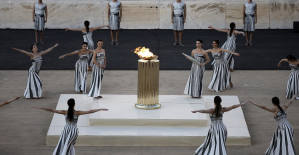Andreas Wellinger pushed off and squatted deeply. The ski jumper raced through the ceramic track on purple plastic tarpaulins towards the take-off table. The 27-year-old jumped off and flew past green fir trees towards the valley at an outside temperature of 13 degrees. After 117.5 meters he landed his jump safely. But Wellinger didn't set the telemark in the snow, but on green mats. What looked like a summer competition in Wisla, Poland, was the start of the winter World Cup season. Although in Wisla nothing felt like winter. The first competition of the season was mostly green and warm.
There were green mats where snow was supposed to be. Lawn sprinklers constantly watered the run-out so that the jumpers can keep up the momentum after landing and don't fall. Wisla was the first Winter World Cup to be held on mats. "It's a good opportunity for us and our sport, especially in the current situation with the climate and energy crisis. We will start the experiment and see what will become of it in the long term,” said Wellinger.
The climate crisis has long since reached winter sports. “Climate change is real. With an ice track and mat, ski jumping would have a solution and a concept to counteract this. That works fine. Now we will see how the public and the fans accept it," said Germany's team manager Horst Hüttel. He could imagine that in the future ski jumping will be held more often on mats than on artificial snow, even in winter.
Green mountains, artificial turf mats and spectators in autumn clothes are not the images that the world association Fis wants to convey. But these are images that everyone has to get used to. Hüttel does not close his eyes to reality: "The question of the future will not be what we want - but what we can do. What can still be represented in our society? The question is: what is the right way?”
It is also true that the FIS decided to start the season extremely early in November because of the World Cup in Qatar. But even in regions that were once considered snow-sure in November, competitions fell victim to the warm weather. The start of the women's Ski World Cup in Sölden, Austria, fell through because of rain. The men's descent on the Matterhorn was canceled due to a lack of snow. The two parallel giant slaloms in Lech am Arlberg next weekend are also on the brink. The German biathletes also had to reschedule and did without a first snow course in the Alps, instead they went to the ski hall in Oberhof in Thuringia.
"I actually wanted to go to Davos for a few days," said Olympic biathlon champion Denise Herrmann. At an altitude of more than 2000 meters, she wanted to prepare for her World Cup winter. But the four-kilometre cross-country trail has not yet been prepared as planned - it's much too warm in Switzerland. The warmest October since records began in 1864 has come to an end there. Under the influence of the foehn, the daily average temperature in some regions was eight to nine degrees above the long-term average. "We have to change our plans. The weather isn't so easy right now," said Herrmann.
While alpine racers, biathletes and cross-country skiers urgently need snow and artificial snow, ski jumpers can do without it. In times of climate change, jumpers are happy to have the easy option of mat jumping. But as a permanent state? "I wish it wasn't the future. That would be a bad sign. Of course you hope to see more ski jumping in a white winter landscape,” said former world-class athlete Martin Schmitt. "Now this is an experiment. We'll see how it works."
The future predicted by Schmitt already seems to be the present in many places. German snowboarders felt the effects of this this summer. “We have all seen the impact climate change is having on glaciers around the world. If we were to fly to South America for training now, we would be part of the problem and not the solution,” said President Hanns-Michael Hölz of Snowboard Germany. Since the Zermatt glacier had closed its summer operations, the racers around Stefan Baumeister had to reschedule and switch to Saas-Fee. "If you then sit in the hotel in Saas-Fee and the water flows down the mountain and you know that it's not melted snow but melted ice from the glacier, you start to think," said Baumeister.
In Wisla the water came from the sky in the second round. In the pouring rain, local hero Dawid Kubacki secured victory. Wellinger only ended up in 23rd place, the best German was surprisingly Pius Paschke, who finished twelfth after jumps of 122.5 and 122 meters. The second competition in Wisla will take place again on green mats on Sunday. After a two-week break, the show continues on November 26th in Ruka, Finland. There is even some snow near the Arctic Circle.

 War in Ukraine: when kyiv attacks Russia with inflatable balloons loaded with explosives
War in Ukraine: when kyiv attacks Russia with inflatable balloons loaded with explosives United States: divided on the question of presidential immunity, the Supreme Court offers respite to Trump
United States: divided on the question of presidential immunity, the Supreme Court offers respite to Trump Maurizio Molinari: “the Scurati affair, a European injury”
Maurizio Molinari: “the Scurati affair, a European injury” Hamas-Israel war: US begins construction of pier in Gaza
Hamas-Israel war: US begins construction of pier in Gaza First three cases of “native” cholera confirmed in Mayotte
First three cases of “native” cholera confirmed in Mayotte Meningitis: compulsory vaccination for babies will be extended in 2025
Meningitis: compulsory vaccination for babies will be extended in 2025 Spain is the country in the European Union with the most overqualified workers for their jobs
Spain is the country in the European Union with the most overqualified workers for their jobs Parvovirus alert, the “fifth disease” of children which has already caused the death of five babies in 2024
Parvovirus alert, the “fifth disease” of children which has already caused the death of five babies in 2024 Inflation rebounds in March in the United States, a few days before the Fed meeting
Inflation rebounds in March in the United States, a few days before the Fed meeting Video games: Blizzard cancels Blizzcon 2024, its annual high mass
Video games: Blizzard cancels Blizzcon 2024, its annual high mass Falling wings of the Moulin Rouge: who will pay for the repairs?
Falling wings of the Moulin Rouge: who will pay for the repairs? “You don’t sell a company like that”: Roland Lescure “annoyed” by the prospect of a sale of Biogaran
“You don’t sell a company like that”: Roland Lescure “annoyed” by the prospect of a sale of Biogaran Exhibition: in Deauville, Zao Wou-Ki, beauty in all things
Exhibition: in Deauville, Zao Wou-Ki, beauty in all things Dak’art, the most important biennial of African art, postponed due to lack of funding
Dak’art, the most important biennial of African art, postponed due to lack of funding In Deadpool and Wolverine, Ryan and Hugh Jackman explore the depths of the Marvel multiverse
In Deadpool and Wolverine, Ryan and Hugh Jackman explore the depths of the Marvel multiverse Tom Cruise returns to Paris for the filming of Mission Impossible 8
Tom Cruise returns to Paris for the filming of Mission Impossible 8 Skoda Kodiaq 2024: a 'beast' plug-in hybrid SUV
Skoda Kodiaq 2024: a 'beast' plug-in hybrid SUV Tesla launches a new Model Y with 600 km of autonomy at a "more accessible price"
Tesla launches a new Model Y with 600 km of autonomy at a "more accessible price" The 10 best-selling cars in March 2024 in Spain: sales fall due to Easter
The 10 best-selling cars in March 2024 in Spain: sales fall due to Easter A private jet company buys more than 100 flying cars
A private jet company buys more than 100 flying cars This is how housing prices have changed in Spain in the last decade
This is how housing prices have changed in Spain in the last decade The home mortgage firm drops 10% in January and interest soars to 3.46%
The home mortgage firm drops 10% in January and interest soars to 3.46% The jewel of the Rocío de Nagüeles urbanization: a dream villa in Marbella
The jewel of the Rocío de Nagüeles urbanization: a dream villa in Marbella Rental prices grow by 7.3% in February: where does it go up and where does it go down?
Rental prices grow by 7.3% in February: where does it go up and where does it go down? Even on a mission for NATO, the Charles-de-Gaulle remains under French control, Lecornu responds to Mélenchon
Even on a mission for NATO, the Charles-de-Gaulle remains under French control, Lecornu responds to Mélenchon “Deadly Europe”, “economic decline”, immigration… What to remember from Emmanuel Macron’s speech at the Sorbonne
“Deadly Europe”, “economic decline”, immigration… What to remember from Emmanuel Macron’s speech at the Sorbonne Sale of Biogaran: The Republicans write to Emmanuel Macron
Sale of Biogaran: The Republicans write to Emmanuel Macron Europeans: “All those who claim that we don’t need Europe are liars”, criticizes Bayrou
Europeans: “All those who claim that we don’t need Europe are liars”, criticizes Bayrou These French cities that will boycott the World Cup in Qatar
These French cities that will boycott the World Cup in Qatar Basketball: Strasbourg appeals the victory recovered by Monaco
Basketball: Strasbourg appeals the victory recovered by Monaco Top 14: UBB with Tatafu and Moefana against Bayonne
Top 14: UBB with Tatafu and Moefana against Bayonne MotoGP: Bagnaia dominates qualifying practice in Spain and sets track record
MotoGP: Bagnaia dominates qualifying practice in Spain and sets track record Olympic Games: in Athens, Greece transmits the Olympic flame to France
Olympic Games: in Athens, Greece transmits the Olympic flame to France


















